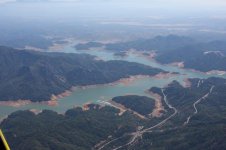Big Cholla
Member
Researched It
Your question caught my interest this evening and so I reached into my bookcase and got my Father's official USBR "CONCRETE MANUAL". The USBR used the building of Hoover Dam as it's laboratory in writing several 'manuals' for establishing Official USBR guidelines for similar construction post Hoover Dam. My Father's best concrete placement crew was used in performing all the various concrete emplacement these experimental tests required. He was given the manual that I have in my hands days after its official publication in 1936. Anyway, The best that I can come up with as far as "The Optimal" temps for the liquid concrete mass is a recommended range of 60 deg. to 70 deg.for development of maximum compress-ability psi. The 'heat of hydration' is exothermic, so the minute water mixes with cement the resulting mix starts producing heat. My Father told me that they used ice cooled water in the mixers (they called them Batch Plants) during the heat of the summer to hold that 'mix' heat down. So, I think your suggested 55 deg. F. is a little low for that optimum mix temp for strength. I did find that all the base lines for affects of variables affecting final strength is based on a mix temp of 70 deg. and a atmospheric temp of 70 deg. So, 70 deg. seems to be a favorite starting place for the USBR Engineers at least in the '30s and '40s. I do know that atmospheric temp is the most uncontrolled variable on the job site and that a lot of "ad mixtures" are available to be added to a concrete formula to compensate for too hot of a day temp or a too cold of a day temp.
An aside; Most people have no idea what an important contribution "ice" made to the construction of Hoover Dam. The USBR built a 'state of the art' ice plant along side the railroad in Boulder City. Tons of block and crushed ice went to the dam site every day during the summer with lesser amounts during the winter. Most of the drinking water barrels were iced down. While the Engineers, Construction Bosses and Clerks of the Works, all had buckets of ice in their job shacks with small fans blowing across the ice. Certain fittings of metal pieces had to be iced down while the mating pieces were warmed with 'rosebud blow torches' for a tight field fit.
My Dad said, "If ice wasn't in existence when Hoover Dam construction started, it would of had to be invented." ......
Isn't the best temp for concrete to cure is 55 degrees. They had hose or cooling lines with cold water. They poured the overpasses here at night this summer and ran cooling lines. In the winter they had portable heating lines.
Your question caught my interest this evening and so I reached into my bookcase and got my Father's official USBR "CONCRETE MANUAL". The USBR used the building of Hoover Dam as it's laboratory in writing several 'manuals' for establishing Official USBR guidelines for similar construction post Hoover Dam. My Father's best concrete placement crew was used in performing all the various concrete emplacement these experimental tests required. He was given the manual that I have in my hands days after its official publication in 1936. Anyway, The best that I can come up with as far as "The Optimal" temps for the liquid concrete mass is a recommended range of 60 deg. to 70 deg.for development of maximum compress-ability psi. The 'heat of hydration' is exothermic, so the minute water mixes with cement the resulting mix starts producing heat. My Father told me that they used ice cooled water in the mixers (they called them Batch Plants) during the heat of the summer to hold that 'mix' heat down. So, I think your suggested 55 deg. F. is a little low for that optimum mix temp for strength. I did find that all the base lines for affects of variables affecting final strength is based on a mix temp of 70 deg. and a atmospheric temp of 70 deg. So, 70 deg. seems to be a favorite starting place for the USBR Engineers at least in the '30s and '40s. I do know that atmospheric temp is the most uncontrolled variable on the job site and that a lot of "ad mixtures" are available to be added to a concrete formula to compensate for too hot of a day temp or a too cold of a day temp.
An aside; Most people have no idea what an important contribution "ice" made to the construction of Hoover Dam. The USBR built a 'state of the art' ice plant along side the railroad in Boulder City. Tons of block and crushed ice went to the dam site every day during the summer with lesser amounts during the winter. Most of the drinking water barrels were iced down. While the Engineers, Construction Bosses and Clerks of the Works, all had buckets of ice in their job shacks with small fans blowing across the ice. Certain fittings of metal pieces had to be iced down while the mating pieces were warmed with 'rosebud blow torches' for a tight field fit.
My Dad said, "If ice wasn't in existence when Hoover Dam construction started, it would of had to be invented." ......


